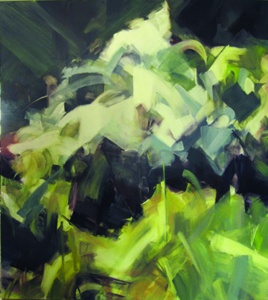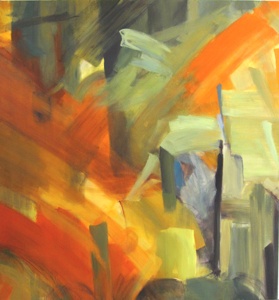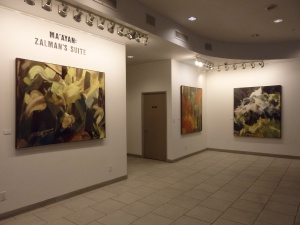Ma’ayan: Zalman’s Suite
Yisgadal v’yisgadash sh’mai rabba b’alma dee v’ra chir’usay.
For many Jews a time will come when we will say these words in minyan every day, many times a day, for 11 months as part of mourning a parent. We bravely declare, “May His great name grow exalted and sanctified in the world that He created as He willed.” Over and over we repeat this plea, this affirmation of the greatness of God who took away our loved one. Our loss becomes the occasion for us to proclaim the glory of God’s name found in His creation, the very world around us.
Ma’ayan, the creator of Zalman’s Suite currently on view at JKlaynberg Gallery, has transformed her mourner’s kaddish into a series of 10 paintings exploring the beginning of God’s creation and the remembrance of her father whose first yarhzeit was January 22. Most notably the paintings are all abstract with titles that reflect verses and concepts from the Torah and her personal memories of her father.
From the age of 8 she has been driven to make art, wonderfully encouraged by her father who frequently told her to “just keep painting,” music to the ears of any aspiring artist. While her work was originally figurative and landscape oriented she has shifted into abstraction as her art has become an integral part of a long spiritual journey. Over the years her concentrated study of Torah, Tanach and Kabbalah has driven her emotions and aesthetic choices into developing a style that she characterizes as “abstract expressionism meets mystical thought.”

And Here I Am suggests a swelling up of abstract forms and energetic brushstrokes that evoke the very beginnings of creation. Most of these paintings are characterized by primal contrasts, luminous blacks and darks that form a contrapposto to vibrant greens and pale yellows. In this painting the forces of darkness, a kind of substantive nothingness, are found combining and supporting gestures of life-giving greens and whites. The sense of light and air that the artist maintains actively creates a depth belying the surface and invites the viewer into the visual universe of the painting.
Mourning for one’s parent is a universal emotion. Countless are the dedications of buildings, shuls, hospitals, libraries, and memorials given in memory of a parent. Artists simply use their creativity to memorialize. Leon Wieseltier’s mourning for his father in 1996 ended up producing the notable book Kaddish that examines the vast corpus of Jewish liturgy, law, legend and tradition. Miriam Stern’s interactive website bethetenth.com is dedicated to her mother who passed away in 2008. The site has created virtual minyanim at which the kaddish can be said and heard showing the text in Hebrew (actually Aramaic) and in transliteration in order to introduce both the concept of kaddish and minyan to a wider audience. Max Miller made over 50 watercolors of the shuls he visited around the country in the year he said kaddish for his father. In reviewing the series shown at Yeshiva University Museum I commented: “It is an homage to a year spent in transformation, in art a memorial to his departed father, celebrated through a son’s creativity. He started as an outsider and has now made us all insiders…. He has shown us the breadth and depth of American Jewry in the multitude of shuls he visited.” No less notably Tobi Kahn dedicated 11 projects of artwork following the passing of his mother in 2004 including paintings on women learning at YOLA Girls High School, 10 paintings on the attributes of Women in Torah, the Jewish Hospice environment in New York, a series of Tzedekah boxes and his suite of Shalom Bat Baby Naming Chairs entrusted to the Abraham Joshua Heschel School in New York. His belief that art can heal and comfort drove his creative memorials.
Ma’ayan’s paintings are energetic expressions of physicality, the sweep of large brushes rage over the surface occasionally allowing a drip or splash to accent otherwise carefully conceived passages. Each of the works have an impressive scale that is echoed in their actual sizes ranging from 4’ x 4’ to almost six feet by five feet. Standing directly in front of the works allows one to begin to fully experience the emotions that stimulated them in the first place. Perhaps their very physicality is an attempt to fill the haunting loss that the death of a parent creates.
She starts her paintings without knowing exactly the subject, rather simply plumbing her emotions and allowing them to surface as aesthetic acts; a color here, a brushstroke there, a line or form brought into being. Then in the process of making the painting, following its own demands and needs that an emerging visual object seems to call out in the artist, she allows her Torah knowledge to interact with the visual phenomenon. Slowly, sooner or later, a title suggests itself and if it is sustained by the visual, begins to give identity to the abstract image. It is crucial to understand that these are not paintings of “things.” The painting itself is the “thing” that is the product of a process that depends upon the complex interaction of three separate phenomena: emotions, making a physical painting and Torah knowledge.

The very nature of abstract images tempts us to assign literal meanings to things we think we see. While that process can help the viewer approach an abstraction, it’s important to allow oneself to simply experience the work, place it in relationship to its title and begin to listen to what the artist is saying using abstract means. Night, Teacher of Faith presents an immediately understandable environment; dark depths loom over a flash of orange, white and pink hedged in by gray rectangular shapes. We feel we are on uncertain ground, a threat experienced by all who have walked down a completely black nighttime street. Then we realize we must let go and simply rely on our faith to make it to the next well of light and safety. This is what we first experience at the death of a parent, the reality of their absence becomes a night of loneliness. We are momentarily lost and alone, struggling for the light.

One of the reasons Ma’ayan attempted this series was that she wanted to try to capture the passion of her father’s life. Remarkably she found a visual metaphor for an aspect of him that perhaps only a religious daughter could imagine. At the End of His Days stands out among this suite of paintings in its bold use of color. Diagonal bands of orange invade the painting from both the right and left. Vertical strokes of gray-green pour down from above while along the lower right a cluster of forms suggest a rocky outcropping overlooking a landscape-like space. The pale whites and yellows create an irresistible airiness. As we notice a thin black shape, more a calligraphic gesture than a form, the meaning of the title becomes apparent: this abstract painting evokes Moshe Rabbeinu overlooking the Land of Israel on the day of his death. As much as he pleads he will not be allowed to enter. The chaos and drama he sees ahead is something he will have no hand in governing. As a man who cannot enter, his loneliness is as palpable as the thin black line he has become. As a parent about to depart from his children the angst is no less.

Making art as an expression of grief is a risky business. It could easily be maudlin, depressed or escapist. Not so with Ma’ayan’s Zalman’s Suite. She has followed the flawless example of the Kaddish, celebrate God’s name and work hard, daily, to bring his honor and glory into the world by remembering and celebrating the parent we have lost but still love and honor. I couldn’t imagine a more moving memorial.
JKlaynberg Gallery
121 West 19 Street, New York, NY
www.jklaynberg.com